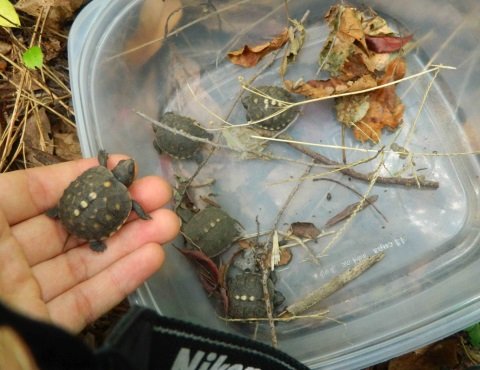Can box turtles be trained to go to specific areas in their enclosure?
Can box turtles be trained to go to specific areas in their enclosure? The answer is, surprisingly, yes! Many pet owners wonder if they can teach their turtles to respond to cues and navigate certain spots within their enclosure. And the good news is that with patience, consistency, and positive reinforcement, it is indeed possible to train box turtles to go where you want them to.
In this blog article, we will explore the fascinating world of box turtle training and share some effective techniques to guide these curious creatures towards specific areas in their habitat. So, let’s dive in and learn more about this intriguing aspect of turtle-care!
Can box turtles be trained to go to specific areas in their enclosure?
Box turtles are fascinating creatures with unique behaviors and habits. Many turtle enthusiasts wonder if it is possible to train box turtles to go to specific areas within their enclosure. While turtles are not traditionally thought of as trainable pets like dogs or cats, they do possess certain instincts and can learn to associate certain cues with specific behaviors. In this article, we will explore the topic of training box turtles and whether it is possible to teach them to go to specific areas in their enclosure.
The Nature of Box Turtles
Before diving into the training aspect, it’s important to understand the natural behavior of box turtles. Box turtles are primarily terrestrial animals, meaning they spend most of their time on land. They are known for their ability to close their shell tightly, protecting themselves from predators. Box turtles are also known to have relatively small home ranges within their natural habitat.
Understanding Box Turtle Behaviors
To effectively train a box turtle, it’s essential to understand their behaviors and instincts. Here are some key behaviors to note:
- Basking: Box turtles are ectothermic, meaning they rely on external sources of heat to regulate their body temperature. Basking is a behavior commonly observed in box turtles, where they seek out sunny spots to warm themselves.
- Foraging: Box turtles are opportunistic omnivores, feeding on a variety of food sources. They have a keen sense of smell and may spend time foraging for insects, fruits, vegetables, and even small vertebrates.
- Exploration: Box turtles are known to explore their environment, constantly moving around in search of food, suitable hiding places, and suitable mates.
Understanding these behaviors will help us determine whether box turtles can be trained to go to specific areas in their enclosure.
Training Box Turtles
While box turtles may not have the same level of trainability as some other pets, they can still learn and respond to certain training techniques. Keep in mind that training a box turtle requires patience, consistency, and positive reinforcement.
Creating a Suitable Enclosure
Before attempting any training, it’s crucial to provide a suitable and enriched enclosure for the box turtle. Here are some factors to consider:
- Size: Ensure the enclosure is spacious enough for the turtle to move around and explore.
- Climatic Conditions: Mimic the natural habitat conditions, including temperature gradients, humidity levels, and suitable basking areas.
- Hideouts and Hiding Places: Provide various hiding spots and sheltered areas to allow the turtle to retreat when needed.
- Natural Substrates: Use substrates like soil, sand, and leaf litter to create a natural environment where the turtle can dig and burrow.
Creating an optimal enclosure will help the turtle feel secure and more inclined to engage in training activities.
Using Target Training Techniques
One method of training box turtles involves using target training techniques. Target training involves teaching the turtle to associate a specific cue or target with a desired behavior. Here’s how it can be done:
- Selecting a Target: Choose a small, distinct object as the target, such as a colored ball or a stick with a flag. The target should be something that the turtle can easily see and distinguish from its surroundings.
- Introducing the Target: Present the target object to the turtle in a non-threatening manner. Allow the turtle to investigate and approach the target at its own pace.
- Associating the Target: As the turtle interacts with the target, provide positive reinforcement, such as a food reward or gentle praise. Repeat this process consistently, associating the target with the reward.
- Targeting Specific Areas: Once the turtle is familiar with the target, start placing it in the desired area of the enclosure. Encourage the turtle to approach the target by providing rewards when it does so.
- Reinforcing the Behavior: Continue to reinforce the behavior of the turtle going to the specific area by offering rewards. Over time, the turtle will learn to associate the target with the desired area.
While target training can be effective for some turtles, it’s important to note that individual turtles may respond differently. Some may show quicker progress, while others may require more time and patience.
Tips for Successful Training
To improve the effectiveness of training box turtles to go to specific areas in their enclosure, consider the following tips:
Consistency:
Consistency is vital when training any animal. Establish a regular training routine and stick to it. The more consistent you are, the quicker the turtle will learn and understand the desired behavior.
Positive Reinforcement:
Using positive reinforcement, such as food rewards or gentle praise, is crucial during training sessions. Box turtles respond well to rewards, and it helps create a positive association with the desired behavior.
Short and Frequent Sessions:
Keep training sessions short, especially when starting. Turtles have limited attention spans, so frequent short sessions focused on one specific behavior or area will yield better results compared to long and intensive sessions.
Observation and Adaptation:
Observe your turtle’s behavior and adjust the training techniques accordingly. Each turtle is unique, and what works for one may not work for another. Be flexible and adapt the training methods based on your turtle’s responses.
Patience:
Patience is key. Training turtles requires time and persistence. Avoid rushing the process and be patient with your turtle’s progress. Remember that every small step forward is a success.
While box turtles may not be as easily trainable as some other pets, they can learn to associate cues and behaviors. Through carefully planned target training techniques and providing a suitable enclosure, it is possible to train box turtles to go to specific areas. Remember, training takes time and consistency, so be patient and enjoy the process of understanding and bonding with your box turtle.
Frequently Asked Questions
Can box turtles be trained to go to specific areas in their enclosure?
Yes, box turtles can be trained to go to specific areas in their enclosure. With patience and consistent training, box turtles can learn to associate certain cues or rewards with specific areas or behaviors.
How can I train my box turtle to go to a specific area in its enclosure?
To train your box turtle, start by identifying the specific area in the enclosure you want them to go to. Use target training, where you present a target stick or object, and when the turtle approaches or touches it, reward them with a treat or praise. Gradually move the target stick closer to the desired area, reinforcing the behavior each time. Repeat this process until the turtle reliably goes to the specific area.
What are some tips for successful training?
Consistency and positive reinforcement are key. Use small, tasty treats like mealworms or strawberries to reward the desired behavior. Keep training sessions short and frequent, as box turtles have short attention spans. Be patient and avoid force or punishment, as it can stress or discourage the turtle.
Can box turtles understand verbal cues?
While box turtles might not understand specific words, they can learn to associate certain sounds or tones of voice with behaviors or actions. By consistently using the same verbal cue before rewarding the turtle, they may begin to recognize the association over time.
Are all box turtles equally trainable?
While individual box turtles may vary in their learning abilities and response to training, most box turtles can be trained to some extent. Some turtles may be more motivated by food rewards, while others might respond better to visual cues or environmental enrichment. Patience and persistence are key when training any box turtle.
Final Thoughts
Box turtles can indeed be trained to go to specific areas in their enclosure. Through positive reinforcement techniques such as rewards and repetition, box turtles can learn to associate certain areas with desired outcomes. By consistently providing treats or praise when they move to the desired area, they can gradually learn to navigate their enclosure accordingly. This training not only enhances their ability to find specific resources or engage in specific behaviors, but also promotes their overall well-being and mental stimulation. With patience and consistency, box turtle owners can successfully train their pets to go to specific areas within their enclosures.

